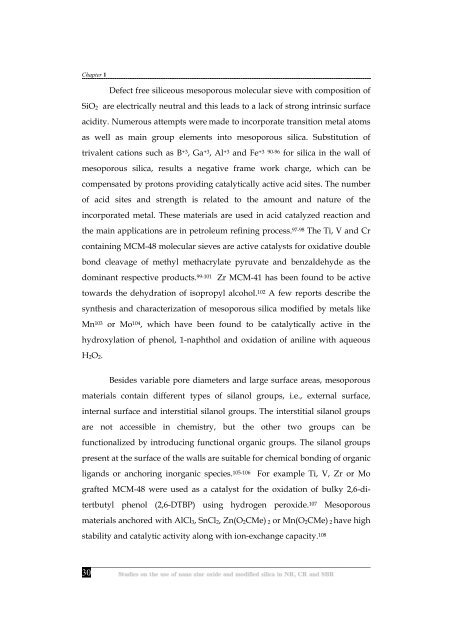Studies on the use of nano zinc oxide and modified silica in NR, CR ...
Studies on the use of nano zinc oxide and modified silica in NR, CR ...
Studies on the use of nano zinc oxide and modified silica in NR, CR ...
Create successful ePaper yourself
Turn your PDF publications into a flip-book with our unique Google optimized e-Paper software.
Chapter 1<br />
30<br />
Defect free siliceous mesoporous molecular sieve with compositi<strong>on</strong> <strong>of</strong><br />
SiO2 are electrically neutral <strong>and</strong> this leads to a lack <strong>of</strong> str<strong>on</strong>g <strong>in</strong>tr<strong>in</strong>sic surface<br />
acidity. Numerous attempts were made to <strong>in</strong>corporate transiti<strong>on</strong> metal atoms<br />
as well as ma<strong>in</strong> group elements <strong>in</strong>to mesoporous <strong>silica</strong>. Substituti<strong>on</strong> <strong>of</strong><br />
trivalent cati<strong>on</strong>s such as B +3, Ga +3, Al +3 <strong>and</strong> Fe +3 90-96 for <strong>silica</strong> <strong>in</strong> <strong>the</strong> wall <strong>of</strong><br />
mesoporous <strong>silica</strong>, results a negative frame work charge, which can be<br />
compensated by prot<strong>on</strong>s provid<strong>in</strong>g catalytically active acid sites. The number<br />
<strong>of</strong> acid sites <strong>and</strong> strength is related to <strong>the</strong> amount <strong>and</strong> nature <strong>of</strong> <strong>the</strong><br />
<strong>in</strong>corporated metal. These materials are <strong>use</strong>d <strong>in</strong> acid catalyzed reacti<strong>on</strong> <strong>and</strong><br />
<strong>the</strong> ma<strong>in</strong> applicati<strong>on</strong>s are <strong>in</strong> petroleum ref<strong>in</strong><strong>in</strong>g process. 97-98 The Ti, V <strong>and</strong> Cr<br />
c<strong>on</strong>ta<strong>in</strong><strong>in</strong>g MCM-48 molecular sieves are active catalysts for oxidative double<br />
b<strong>on</strong>d cleavage <strong>of</strong> methyl methacrylate pyruvate <strong>and</strong> benzaldehyde as <strong>the</strong><br />
dom<strong>in</strong>ant respective products. 99-101 Zr MCM-41 has been found to be active<br />
towards <strong>the</strong> dehydrati<strong>on</strong> <strong>of</strong> isopropyl alcohol. 102 A few reports describe <strong>the</strong><br />
syn<strong>the</strong>sis <strong>and</strong> characterizati<strong>on</strong> <strong>of</strong> mesoporous <strong>silica</strong> <strong>modified</strong> by metals like<br />
Mn 103 or Mo 104, which have been found to be catalytically active <strong>in</strong> <strong>the</strong><br />
hydroxylati<strong>on</strong> <strong>of</strong> phenol, 1-naphthol <strong>and</strong> oxidati<strong>on</strong> <strong>of</strong> anil<strong>in</strong>e with aqueous<br />
H2O2.<br />
Besides variable pore diameters <strong>and</strong> large surface areas, mesoporous<br />
materials c<strong>on</strong>ta<strong>in</strong> different types <strong>of</strong> silanol groups, i.e., external surface,<br />
<strong>in</strong>ternal surface <strong>and</strong> <strong>in</strong>terstitial silanol groups. The <strong>in</strong>terstitial silanol groups<br />
are not accessible <strong>in</strong> chemistry, but <strong>the</strong> o<strong>the</strong>r two groups can be<br />
functi<strong>on</strong>alized by <strong>in</strong>troduc<strong>in</strong>g functi<strong>on</strong>al organic groups. The silanol groups<br />
present at <strong>the</strong> surface <strong>of</strong> <strong>the</strong> walls are suitable for chemical b<strong>on</strong>d<strong>in</strong>g <strong>of</strong> organic<br />
lig<strong>and</strong>s or anchor<strong>in</strong>g <strong>in</strong>organic species. 105-106 For example Ti, V, Zr or Mo<br />
grafted MCM-48 were <strong>use</strong>d as a catalyst for <strong>the</strong> oxidati<strong>on</strong> <strong>of</strong> bulky 2,6-di-<br />
tertbutyl phenol (2,6-DTBP) us<strong>in</strong>g hydrogen per<strong>oxide</strong>. 107 Mesoporous<br />
materials anchored with AlCl3, SnCl2, Zn(O2CMe) 2 or Mn(O2CMe) 2 have high<br />
stability <strong>and</strong> catalytic activity al<strong>on</strong>g with i<strong>on</strong>-exchange capacity. 108

















